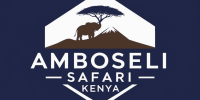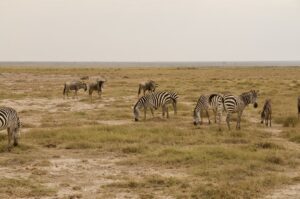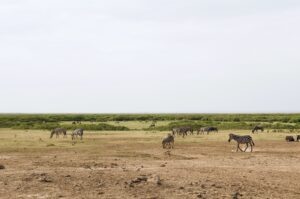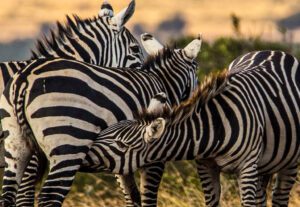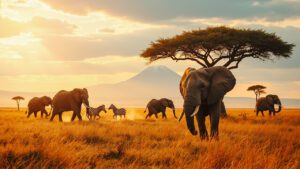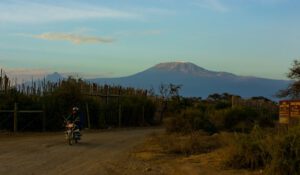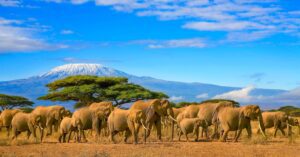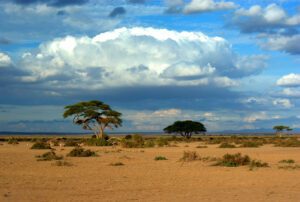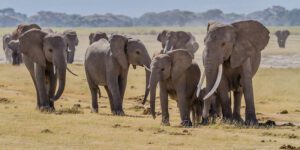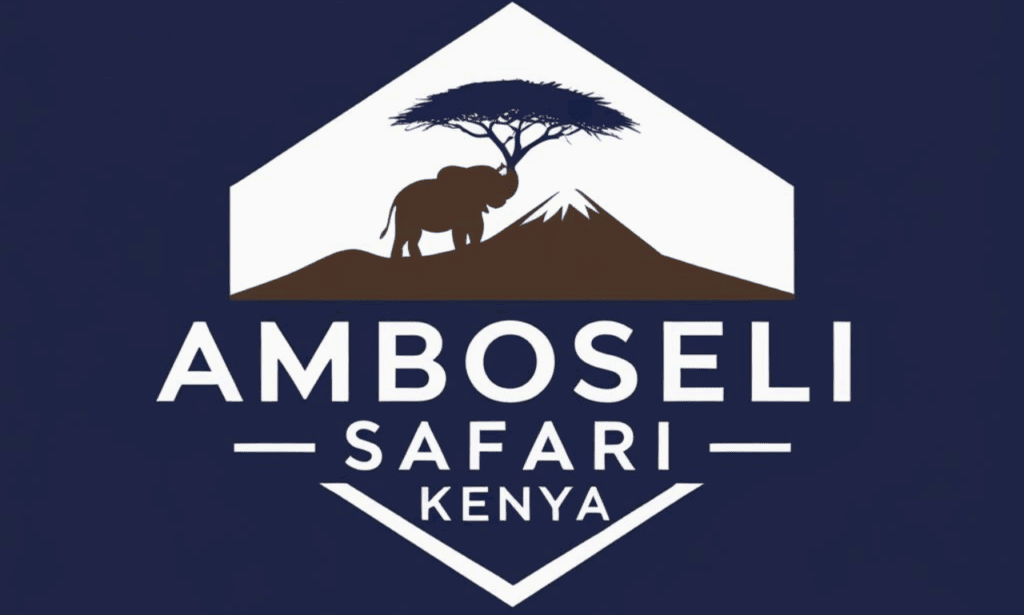What type of clothing should I pack for a safari in Amboseli National Park?
When preparing for a safari in Amboseli National Park, it’s important to prioritize comfort, functionality, and suitability for the environment. Safaris usually involve outdoor activities, warm days, and cooler evenings, so the clothing you pack should take that into account.
Start with lightweight and breathable fabrics like cotton or linen since the weather in Amboseli can get quite hot during the day. Neutral colors such as khaki, beige, or olive green are ideal because they help you blend into the environment. Bright colors can attract insects or distract wildlife, so it’s best to avoid them. Long-sleeved shirts and long pants are great choices because they provide protection from the sun and insects while keeping you cool. If you go for a game drive early in the morning or late in the evening, pack a light jacket or fleece to stay warm, as temperatures can drop quickly.
Bring a wide-brimmed hat to protect yourself from the intense sun and to keep your head cool. A lightweight scarf or bandana is also helpful to shield your neck or face from dust, especially if you’re riding in an open jeep. For an added layer of comfort, wear moisture-wicking materials that dry quickly in case of sweating or light rain.
As footwear and accessories will play a big role in your safari experience too, stay tuned for the footwear section below. Always remember, you don’t need to overpack. A few versatile pieces of clothing that you can mix and match are better than carrying unnecessary bulk.
Do I need to pack specific footwear for the safari?
Yes, footwear is a very important part of your safari experience! During a Kenya safari, especially in Amboseli National Park, you could be stepping out at picnic stops, walking around camp areas, or even venturing into guided walking safaris. Therefore, you need appropriate shoes that are practical, comfortable, and durable.
For daily safari activities, closed-toe shoes are highly recommended. Comfortable hiking boots or sturdy trail shoes are excellent choices because they provide support for uneven terrain and protect your feet from thorns, stones, or other sharp objects. Amboseli’s climate can be dry and dusty, so tough shoes will also help prevent dirt from getting in. Avoid shoes with thin soles or inadequate grip, as they won’t hold up well in rougher environments, especially for first-time safari tourists.
If you’re heading out on a lodge stay or other less physically demanding parts of the safari, you might also want to pack a pair of lightweight sneakers or comfortable walking shoes for more casual activities. Don’t forget to bring socks, ideally made of moisture-wicking material to keep your feet dry and prevent blisters.
For evenings back at the lodge or relaxation time, pack a comfortable pair of sandals or flip-flops to give your feet a chance to breathe. However, these aren’t suitable for the actual game drives or bush walks.
In summary, a combination of hiking boots, walking shoes, and sandals should cover all your needs for your safari trip. Ensure you’ve broken in your shoes beforehand to avoid discomfort during your adventure.
Should I bring any protective gear, such as hats or sunglasses?
Absolutely, protective gear like hats and sunglasses is essential for a kenya safari in Amboseli National Park! The African sun can be extremely harsh, especially during the middle of the day when UV rays are at their strongest. Here’s the gear you’ll need to stay protected while enjoying your wildlife safari experience.
A wide-brimmed hat is a must-have to shield your face, neck, and ears from direct sunlight. Look for hats made of breathable materials like cotton or ones with built-in UV protection. A hat with a chin strap is especially useful because it won’t blow off during windy game drives. If you don’t have a wide-brimmed hat, even a baseball cap is better than nothing, but remember to protect your neck with a scarf or bandana.
Sunglasses are equally important to protect your eyes from the sun’s glare. Choose a pair with UV protection and polarized lenses, as they not only block harmful rays but also reduce glare, making it easier to spot incredible wildlife on the horizon. If you wear prescription glasses, consider getting prescription sunglasses or clip-on shades to stay comfortable.
To complement your protective gear, you might also carry a lightweight scarf or buff to shield your face and neck from dust, especially since Amboseli can get windy and vehicles create dust clouds on the dirt roads.
By packing this gear, you’ll ensure that you’re prepared for long hours outdoors while keeping yourself safe from the sun and dust on your safari trip.
What essential items should I pack for protection against insects or the sun?
When you’re on a safari in a beautiful place like Amboseli National Park, you’re spending a lot of time outdoors. This means you’ll need to think about protecting yourself from insects (like mosquitoes) and the sun. These might not seem like big concerns at first, but without the right precautions, they can make your experience uncomfortable or even dangerous. Here are the most essential items to pack for protection:
- Insect Repellent: Pack a strong insect repellent, preferably one with DEET or natural oils like eucalyptus. Mosquitoes in African safari regions can carry diseases like malaria, so it’s crucial to guard against bites, especially in the evenings. Apply repellent to exposed skin and even your clothes, since bugs sometimes bite through thin fabrics.
- Clothing That Protects: Wearing long-sleeved shirts, long pants, and socks can help reduce insect bites and protect your skin from overexposure to the sun. Light-colored clothes are key because they attract fewer mosquitoes and help keep you cool under the sun.
- Sunscreen: The sun in Amboseli can be strong, so sunscreen with a high SPF (30 or above) is essential. Apply it generously to all exposed skin, especially your face, neck, arms, and hands. Reapply throughout the day, particularly if you’re sweating.
- Wide-Brimmed Hat: A hat isn’t just for style, it’s practical. It keeps the sun off your face, neck, and shoulders, areas that are vulnerable to sunburn. Choose a breathable, foldable hat so it’s easy to pack.
- Sunglasses: The glare of the sun in open spaces can strain your eyes. Bring polarized sunglasses for extra protection and to help you enjoy the views without squinting.
- After-Bite Cream or Anti-Itch Solutions: Even with precautions, you might still get bitten by insects. In case that happens, carry a soothing cream to reduce itching and swelling.
By packing these items, you’ll stay comfortable, healthy, and able to fully enjoy your safari experience. A good example is applying sunscreen before getting in a safari vehicle and wearing a hat during your animal-spotting adventures, this way, you can focus on the elephants and zebras without worrying about sunburn or mosquito bites!
Are there specific toiletries or medications I should carry?
Good planning for your safari includes thoughtful packing of toiletries and medications to ensure you’re prepared for anything. Amboseli National Park is a remote location, so you won’t have quick access to shops or pharmacies. Here’s what you need to bring:
- Basic Toiletries: Pack travel-sized essentials like toothbrush, toothpaste, soap, shampoo, and deodorant. Wet wipes or sanitary wipes are perfect for cleaning your hands and face when water is limited during game drives. A small bottle of hand sanitizer is also a must.
- Medication for Common Issues:
- Malaria Prevention: Check with your doctor about taking malaria prophylactic medication, which is often recommended for safaris in mosquito-prone areas.
- Travel Medicines: Carry anti-diarrheal pills (like Imodium), rehydration salts, and OTC painkillers (such as ibuprofen or paracetamol). Stomach upsets can sometimes happen when you’re eating food your system isn’t used to, so having these helps.
- Antihistamines: These can help relieve insect bite reactions, allergies, or minor rashes.
- Prescribed Medications: Bring enough of your prescription medications to last the trip, plus extra in case of delays.
- First Aid Basics: Besides medication, pack basic first aid supplies like adhesive bandages, antiseptic cream, tweezers, and gauze. Cuts and scratches are possible during nature walks, and you’ll want to treat them quickly.
- Skincare Needs: The dry, dusty safari environment can affect your skin. Include moisturizer, lip balm with SPF, and aloe vera gel (to soothe sunburns if they occur).
- Feminine Hygiene Products: If you need them, bring enough tampons, sanitary pads, or menstrual cups. These may not be readily available in the local area.
By being prepared with all these items, you’ll avoid the stress of getting sick or uncomfortable far from your usual medical resources. Picture this: On a four-hour game drive, having lip balm for dry lips and rehydration salts if you’re dehydrated will keep you feeling great and able to enjoy the view of a pride of lions!
Should I bring any snacks or a water bottle for the safari?
Absolutely, bringing snacks and a water bottle is a great idea for your safari in Amboseli National Park. Let’s break this down:
- Water Bottle: Keeping hydrated is essential. The safari environment can be hot and dry, and spending hours in a safari vehicle can dehydrate you quickly. A reusable water bottle or a hydration flask is your best option. Some lodges and safari operators provide you with filtered water, so you can refill your bottle instead of needing bottled water all the time. This is also more eco-friendly. Insulated bottles are especially nice as they keep water cool longer.
- Snacks for Energy: Safaris can involve hours of animal-spotting, and lunch might not always be right on time. Pack some non-perishable snacks like granola bars, trail mix, dried fruits, or crackers. They’re small, easy to carry, and packed with energy to keep you going. For example, while waiting by a watering hole to see elephants, munching on a granola bar can keep you from feeling fatigued.
- Respect Wildlife Rules: While snacking, always keep your food inside the vehicle and never feed the animals. Feeding wildlife is dangerous for both the animals and the humans involved because it disrupts their natural behavior and could make them aggressive.
- Containers for Snacks: Use reusable snack bags or small containers. This reduces waste and keeps your safari eco-friendly. Plastic bags are banned in Kenya, so avoid them altogether.
By packing a water bottle and snacks, you’ll be much more comfortable on your adventure. You won’t have to worry about hunger or thirst while you’re marveling at elephants, flamingos, and Mount Kilimanjaro in the distance!
Is it necessary to pack electronic gadgets or photography equipment for the trip?
In short, yes, it’s necessary to pack electronic gadgets and photography equipment for your safari in Amboseli National Park, especially if you want to capture your memories, stay connected, or navigate effectively. Let’s break this down simply.
Amboseli is home to stunning landscapes, including Mount Kilimanjaro as a backdrop, and diverse wildlife like elephants, lions, and flamingos. Having a good camera is highly recommended to photograph these incredible sights. If you’re serious about wildlife photography, consider bringing a DSLR or mirrorless camera with a telephoto lens (like 200mm or 400mm) because animals may be far away. For casual photography, a high-quality smartphone or a point-and-shoot camera can also work.
Other useful electronics include a power bank or portable charger because charging facilities may not always be available during the safari. Also, spare memory cards for your camera are essential since you’ll likely take a lot of pictures. Don’t forget an adapter if outlets in Kenya differ from your home country.
If you enjoy documenting your trip, gadgets like GoPros or small action cameras are great for capturing videos of bumpy safaris or panoramic shots. However, don’t overload yourself with gadgets; simpler is sometimes better.
For examples: If you don’t bring a camera with a zoom lens, you might miss out on a clear photo of a lioness lounging under a tree. On the other hand, a good smartphone with some zoom capabilities can capture a fantastic image of a group of elephants crossing in front of Mt. Kilimanjaro.
Finally, don’t forget headphones for personal entertainment during downtime and maybe a GPS watch or app to track your safari routes. Just ensure that all your gadgets are portable and don’t require too much maintenance while you’re in the wild.
What kind of bag or luggage is best suited for a safari?
The best bag or luggage for a safari in Amboseli National Park is lightweight, durable, and easy to carry. Safaris often involve a lot of movement, whether you’re bouncing along in a jeep, staying in a campsite, or transferring between parks, so your bag needs to be practical and not oversized.
Soft-sided duffel bags or backpacks are typically the best choice over hard-shell suitcases. Why? Because safari vehicles, especially in Amboseli, usually have limited luggage space, and soft bags are easier to squeeze into these tight areas. Hard suitcases are bulky and may get scratched, dented, or damaged on those bumpy, dusty roads.
As for size, aim for a bag between 50-70 liters, depending on how long your trip is. Most airlines and safari packages also have strict weight limits, as small planes often transport travelers between parks. Pack light, around 15 kg (33 lbs), to stay within these limits.
Make sure your bag is durable enough to handle rough conditions like dust or loading/unloading from jeeps. A waterproof or weather-resistant bag is especially useful because Amboseli can have muddy or rainy spots, depending on the season.
For day trips, a small, comfortable backpack is perfect. This is where you’ll keep your essentials during your daily safari drives: water bottles, cameras, notebooks, and snacks. Ideally, this smaller bag should have multiple compartments for organization and be easy to carry for long periods.
For example: While traveling through Amboseli, a lightweight duffel bag for your main gear and a 20-30 liter daypack for essentials is the perfect combo. It allows you to stay mobile and adapt to the rugged safari lifestyle.
Do I need to pack binoculars or wildlife-spotting tools?
Absolutely, bringing binoculars is a great idea for a safari in Amboseli because you’ll encounter animals both near and far. While some animals, like elephants or zebras, may walk right past your vehicle, others, like lions, cheetahs, or rare birds, may be harder to spot in the distance. Binoculars will help you see those creatures up close without disturbing them.
A good pair of binoculars can make your safari experience much more exciting and immersive. Look for ones with a magnification of 8x or 10x, this means you can see objects 8-10 times closer than with your naked eye. You also want binoculars with a wide field of view to track animals on the move. Brands like Nikon, Bushnell, or Zeiss offer excellent options for safari-goers.
If you have kids or are sharing binoculars, look for lightweight and compact options that are easy to handle.
For birdwatchers, Amboseli is known for its colorful and diverse bird population. In that case, binoculars are almost essential because birds are often small and perched high up in trees or flying overhead.
Other wildlife-spotting tools could include a monocular (a smaller one-eyed version of binoculars) if you’re looking for something ultra-lightweight, or even a portable spotting scope for detailed views of distant animals.
For example: Imagine seeing elephants up close with the naked eye but then spotting a cheetah resting under a tree far away. Without binoculars, that cheetah might look like just a blurry dot to you! With binoculars, you’ll fully appreciate the details of its posture, coat, and surroundings.
If you’d prefer to pack light, some safari vehicles provide binoculars to share, but they may not always be available or in the best condition. It’s better to bring your own pair to avoid missing any details during your adventure.
Should I include a first aid kit or emergency essentials in my packing?
Yes, packing a first aid kit and some emergency essentials for a safari in Amboseli National Park is very important. While many safari tours are well-prepared for emergencies and Wilderness First Aid, it’s always a good idea to have your own basic supplies to handle minor injuries or unexpected illnesses.
Your first aid kit should include items that can help with small cuts, scrapes, insect bites, or light pain relief. For example, pack adhesive bandages (Band-Aids), antiseptic wipes, sterile gauze, tweezers (for removing thorns or splinters), and an antibiotic cream for cuts. Include over-the-counter painkillers like ibuprofen or acetaminophen for headaches or general aches (safari rides can sometimes get bumpy). Bring anti-diarrheal medicine (like Imodium) and rehydration salts, since traveling to new environments or different food might upset your stomach.
Remember insect bites: Amboseli has mosquitoes and other bugs because of the park’s natural setting. Adding antihistamines (for allergies or mild reactions to bites), hydrocortisone cream (for itching), and even motion sickness pills (if you’re prone to nausea on bumpy roads) can be very useful.
Emergency essentials don’t need to be complicated. A small whistle can alert someone if you’re in trouble. Many travelers also pack a flashlight or headlamp, just in case you’re in the bush after the sun sets. A mini multi-tool or Swiss Army knife can be incredibly handy for little tasks like cutting, opening packaging, or fixing straps.
To summarize: a compact first aid kit can save you from inconveniences on your safari. Always check with your guide or safari company and balance packing lightweight necessities without overloading. Safaris are meant to be exciting adventures, but a first-aid kit ensures you’re prepared for the unexpected!
Are there any specific safari-related travel documents or permits I need to pack?
Yes, there are key travel documents and permits you’ll need before heading on your Kenya safari in Amboseli National Park. Safaris involve crossing into conserved wildlife zones, and travel to Kenya has requirements too. Keeping these documents organized and ready can save time and reduce any stress during the trip.
First, you’ll need your passport. Make sure it’s valid for at least six months beyond the date of your trip. Some countries also require a visa to enter Kenya, so check if you’re eligible for e-visas or if you’ll need to apply beforehand. Always carry printed (and digital) copies of your passport and visa, just in case.
You’ll also need your park entry permits or receipts for Amboseli National Park. Typically, these are managed by the safari tour operator you book with, but it’s wise to confirm this ahead of time to avoid confusion when you arrive. If you’re self-driving or planning to book activities onsite, you might need to pay park fees separately, so it’s best to research any rules in advance.
Vaccination certificates are another important consideration. Kenya sometimes requires proof of a yellow fever vaccination if you’re coming from another country where yellow fever is common. Because Amboseli is located in a malaria-risk area, bringing proof of preventative measures, like malaria medications, might also be helpful.
Other documents to carry include travel insurance, which covers health emergencies, trip cancellations, and so on. Print copies of your safari itinerary as well, if you book with a guide or company. It’s useful to show staff members your plans to avoid miscommunication.
Lastly, pack a small notebook with emergency contact information (like your embassy) and proof of bookings for accommodations or transportation. Keeping all these documents in a waterproof folder ensures they stay undamaged and accessible! Planning in advance makes your safari trip a breeze.
What optional items could enhance my safari experience in Amboseli?
There are several optional items you can pack to enhance your kenya safari experience in Amboseli National Park. While these items aren’t mandatory, they can add comfort, convenience, and a little extra “wow” to your adventure!
First, a good-quality camera or smartphone is essential for capturing stunning moments. You’ll see incredible landscapes, towering Mount Kilimanjaro in the background, and kenya wildlife like elephants, giraffes, and lions. Consider a DSLR camera with a zoom lens for clearer, professional-looking shots, or portable binoculars with a built-in camera for both spotting and snapping pictures.
A compact pair of binoculars is another great addition, even if you’re not into photography. Animals in Amboseli are often at a distance, and binoculars will help you get up-close views of lions lounging in the grass or bird species like flamingos and herons near the wetlands.
For your own comfort, think about a lightweight travel cushion for bumpy game drives. Long hours on a safari jeep can be tiring, especially if you’re bouncing on gravel roads, so having a comfortable seat cushion will help you enjoy the ride more.
An additional optional item is a wildlife field guide or app specific to East Africa’s animals and plants. It can turn your safari into a learning experience, as you’ll recognize animal behaviors and identify lesser-known species. Your guides are knowledgeable, but sometimes having your own book helps deepen appreciation for what you’re seeing.
Lastly, consider packing a journal to record your adventures or a portable power bank to keep your electronics charged throughout the day. You’ll be outdoors a lot, which is amazing, but it often makes access to charging points tricky. A quality safari hat or even a buff (a versatile fabric head covering) can also be optional but very useful.
Little extras like these can elevate your safari from a great trip to an unforgettable one!
